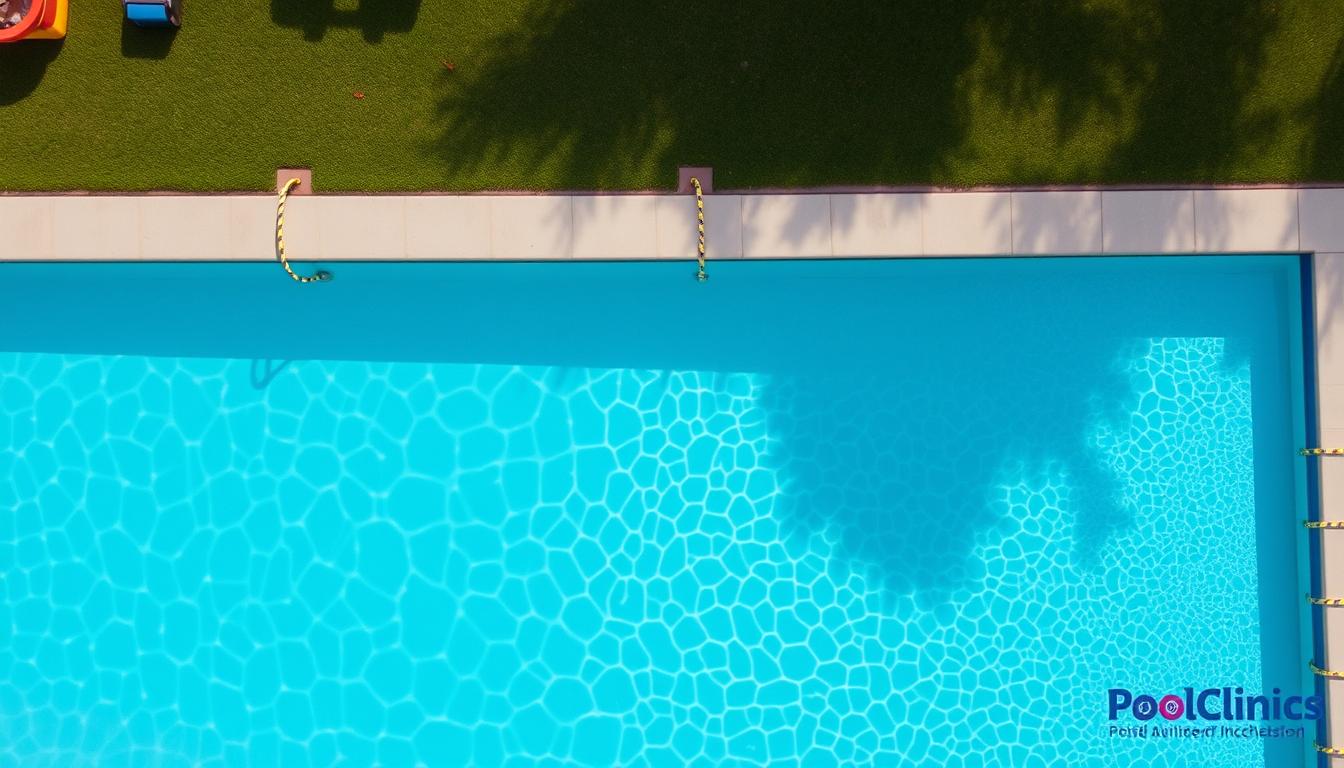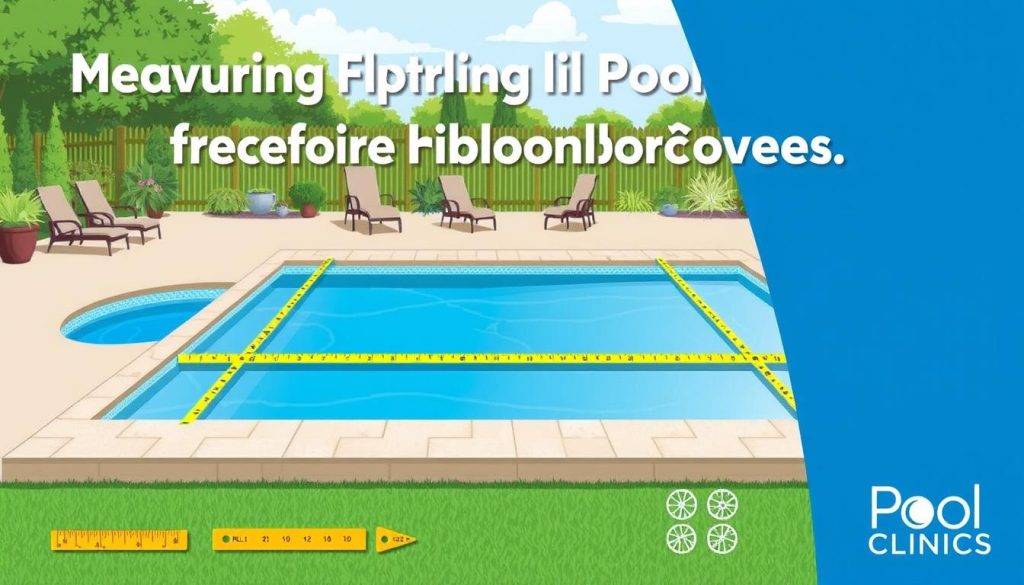
Pool safety covers are essential for off-season protection. 85% of pool owners use them to safeguard their investments. Accurate measurements ensure a perfect fit for your pool cover.
A well-fitted cover prevents debris buildup and enhances your pool’s appearance. It also helps retain heat and keeps your loved ones safe. Proper sizing is crucial for these benefits.
Measuring your pool might seem tricky, but it’s doable with the right guidance. This guide will help you determine your pool cover dimensions. We’ll cover all pool shapes, including those with unique features.
A properly fitted pool cover saves time and effort in maintenance. It also extends your pool’s lifespan. Accurate measurements ensure your pool stays pristine for the next swimming season.
Key Takeaways
- 85% of pool owners use safety covers to protect their pools during the off-season
- Accurate pool cover measurements prevent debris accumulation, enhance aesthetics, retain heat, and ensure safety
- Measuring your pool for a cover involves determining pool shape, measuring dimensions, and accounting for special features
- Choosing the right pool cover material and type depends on your specific needs and preferences
- Investing in a well-fitted pool cover saves time, effort, and extends your pool’s lifespan
Why Accurate Pool Cover Measurements Matter
Precision is crucial when finding the right pool cover size. Proper measurements ensure a perfect fit for your pool cover. This provides optimal protection and performance for your pool.

Preventing Debris Accumulation
A pool cover keeps debris out of the water. A well-fitted cover forms a tight seal over the pool’s surface. This keeps your pool cleaner and reduces strain on your filtration system.
A proper cover extends your filtration system’s lifespan. It also saves you money on maintenance costs.
Enhancing Aesthetic Appeal
A well-fitted pool cover improves your pool area’s appearance. It creates a neat look without wrinkles or sagging. This maintains visual harmony in your outdoor space when the pool isn’t used.
Retaining Heat and Reducing Costs
Pool covers are crucial for heat retention. They form a barrier that minimizes heat loss to the environment. This keeps your pool water warmer for longer periods.
You can enjoy comfortable swimming without relying on heating systems. This reduces energy bills and saves money over time.
| Pool Cover Benefits | Statistics |
|---|---|
| Evaporation Reduction | Up to 95% |
| Annual Water Loss (Uncovered) | 12,000 to 31,000 gallons |
| UV Protection for Chlorine | Reduces degradation |
| Energy Efficiency | Extends swimming season, reduces heating costs |
Ensuring Safety and Preventing Accidents
Safety is the most critical aspect of proper pool cover sizing. Drowning is a leading cause of unintentional death among young children. A well-fitted cover is essential for pool safety.
Ill-fitting covers can leave dangerous gaps or create unstable surfaces. A correctly sized cover acts as an effective barrier against accidents.
According to the Consumer Product Safety Commission, pool covers can significantly reduce the risk of drowning when used correctly and in conjunction with other safety measures.
Accurate pool measurements are an investment in your pool’s health and safety. A well-fitted cover prevents debris, enhances aesthetics, retains heat, and ensures safety. It’s an essential part of responsible pool ownership.
Steps to Measure Your Pool for the Perfect Cover Fit
Accurate pool measurements ensure a well-fitted cover. Follow these steps to determine the right size for your pool cover. You’ll enjoy a protected pool year-round.
Determine Your Pool Shape
Start by identifying your pool’s shape. Common shapes include rectangular, round, and oval. Knowing the shape helps you take the right measurements.
Measuring Rectangular Pools
For rectangular pools, measure the length and width at the longest points. This ensures your cover will provide complete protection for the entire pool surface.
Measuring Round Pools
Round pools require measuring the diameter. Measure across the center from one edge to the other. This helps calculate the circumference for a snug fit.
Measuring Oval Pools
Oval pools need length and width measurements. Measure the longest points for length and widest points for width. This ensures full coverage without gaps.
Accounting for Special Features and Obstacles
Take extra measurements for unique features like steps or ledges. Measure from the pool’s edge to nearby obstacles. This ensures proper clearance for your cover.
| Pool Shape | Measurement Technique |
|---|---|
| Rectangular | Measure length and width at the longest and widest points |
| Round | Measure the diameter across the center of the pool |
| Oval | Measure the longest points for length and widest points for width |
Double-Checking Measurements for Accuracy
Always double-check your measurements to avoid mistakes. Precision is key when determining your pool cover size. For complex designs, consider consulting a professional.
Accurate measurements help you select the right pool cover size. A well-fitted cover maintains cleanliness, safety, and visual appeal. Choose standard or custom-made covers based on your needs.
Choosing the Right Pool Cover Material and Type
Selecting the perfect pool cover is crucial for your inground pool. Your choice depends on climate, pool usage, and specific needs. Let’s explore popular options for winter and shade covers.
Mesh Safety Covers
Mesh safety covers are lightweight and versatile for inground pools. They allow sunlight and water through while filtering out debris. These covers are easy to clean and store, lasting 10-15 years.
Mesh covers work best in mild climates with minimal debris. They provide reliable protection for your pool during winter months.
Solid Safety Covers
Solid safety covers offer maximum protection against debris and water evaporation. They prevent light from passing through, reducing algae growth in your pool. These covers are ideal for areas with significant debris.
Solid covers are the most durable and expensive option. They provide the best protection during winter months.
Thermal Covers
Thermal covers, or insulating covers, are thicker than standard solar covers. They provide superior insulation to retain heat in your pool water. These covers can extend your swimming season and keep your pool warmer.
Thermal covers are perfect for maximizing energy efficiency. They help maintain a comfortable water temperature for longer periods.
According to recent studies, pool covers can raise your pool’s water temperature by several degrees, extending the swimming season and providing substantial energy savings.
Leaf Net Covers
Leaf net covers are designed to catch leaves and larger debris. They make pool maintenance easier and are often used with other covers. These covers are essential for pool owners in areas with abundant foliage.
Leaf net covers ensure a clean and clear pool when it’s time to open for the season.
| Pool Cover Type | Key Features | Best For |
|---|---|---|
| Mesh Safety Covers | Lightweight, allows water and light through, filters debris | Mild climates, minimal debris |
| Solid Safety Covers | Maximum protection, prevents evaporation and algae growth | Areas with significant debris, maximum protection |
| Thermal Covers | Superior insulation, retains heat, extends swimming season | Energy efficiency, maintaining comfortable water temperature |
| Leaf Net Covers | Catches leaves and large debris, simplifies cleaning | Areas with abundant foliage, used with other covers |
Consider your specific needs when choosing a pool cover for your inground pool. There’s a solution to keep your pool protected and ready for the next swimming season.
Conclusion
Choosing the correct pool cover size is vital for protection and functionality. Measure your pool accurately, considering its shape and unique features. This ensures you select a cover that fits perfectly and meets your needs.
Follow proper measuring techniques for your pool’s shape. Account for special features like diving boards or stairs. Double-check your measurements to avoid mistakes that could cause poor fit.
A well-fitting, high-quality pool cover offers peace of mind. It protects your pool and keeps it ready for use. The right cover minimizes maintenance and ensures safety for your family.







